Resource 5: Traditional musical instruments
![]() Background information / subject knowledge for teacher
Background information / subject knowledge for teacher
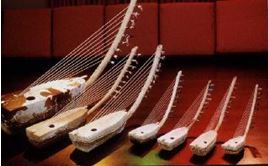 | The movable rings achieve the ideal sound on the ennanga, placed just below the tuning pegs. The strings vibrate against these rings and produce a buzzing sound. This sound is also heard on some of the lyres and sansa. The strings on this instrument are arranged in progressive order from high to low notes. The first, second and third strings form octaves with the sixth, seventh and eighth strings respectively. The Ganda harpist occupied a high social position, performing solely for the kabaka and a few important chiefs. He was the only musician allowed to amuse the royal ladies in their private rooms. Nowadays it is popular as the adungu and widely used in Catholic and Protestant rural churches. |
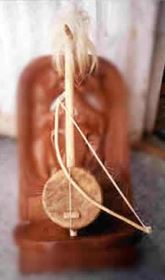 | The exact origin of this fiddle is not known. The traditional story says that, about 1907, the inventor either dreamed about it or saw one being carried by a stranger, perhaps a Kikuyu porter. The resonator of the early fiddle was made of a gourd like a Kikuyu instrument. The inventor thought the instrument was similar to the children's ground bow sekitulege and, after making one, he played the children's song on it. The fiddle has become very popular for light music. |
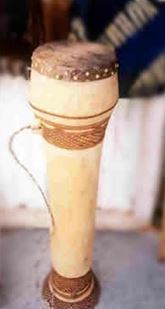 | The traditional fumbo has a reptile skin nailed to the wood, however, due to environmental reasons, the government has long discouraged this practice. The engalabi from Buganda Region, which is played in music theatres, plays an important part in the ceremony called ‘Okwabya olumbe’. This is the installation of a successor to the deceased, thus the saying in Luganda ‘Tugenda mungalabi’, meaning we are going to the engalabi, that is, long drum. The rule in playing the drum is the use of bare hands. |
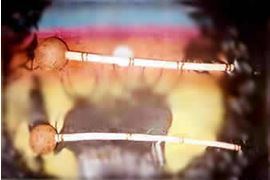 | Ensasi is a set of two gourd shakers sometimes with stick handles used to accompany all the other instruments in Ugandan traditional music from most parts of the country, most especially the central and eastern parts. The type used in northern Uganda (Ajaa) have different shapes, which produce a continuous sound as the beads move from side to side in a gourd or tin shell with multiple holes. The different varieties have spread across regions and cultures over the years. |
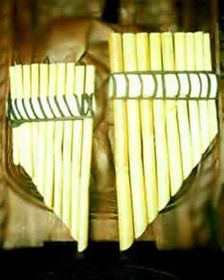 | The panpipe is called enkwanzi or oburere, which means little flutes, and are made from elephant grass or bamboo. They are called stopped flutes because the nodes of the grass block the passage of air through the flute and determine pitch. The Ambu flutes are called stopped flutes for the same reason. The flutes are arranged from lowest to the highest notes and then laced with a string. The open rim at the top is cut at right angles to the tube and the musician blows across the hole as one would do with a bottle. The melodic possibilities produced by the panpipe and by sets of flutes perhaps influenced the development of flutes with finger holes such as the Teso tribe flute and notched flutes. |
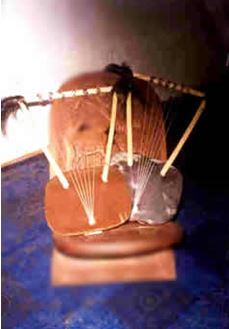 | The Baganda and the Basoga lyre are made of lizard skin and laced to a non-sonorous skin in the same manner as the harp and drums. The strings are tied into a piece of wood and inserted into a hole where the two arms of the lyre meet. The Ganda lyre (endongo) has one hole, the Soga instrument (entongoli) has two pieces of cloth, barkcloth or banana fibres wrapped around the yoke. The strings are wound round and round this material until it acts as a tuning peg. The strings on the bowl lyre are not arranged in progressive order, as they are on the arched harp and the zither. The highest note in the scale is third from the left and the lowest, fifth. Strings 7, 2, 4, 1 and 5 are octaves. |
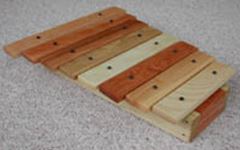 | The keys are separated by either long sticks (Baganda) or short ones (Bakonjo, Basoga use either long or short) and are placed on banana stems. In the pre-colonial era, the amadinda keys were tied in place by threading fibre through small holes in the wood. Akadinda has two shoulders carved on the bottom so that it will not move when it is placed on the banana stems. The keys of the xylophone, which are not tied or otherwise fixed, are kept in place when being played, by the musician’s toes or young boys. Nowadays the whole instrument is made of wood. The akadinda has 17 keys. In the past, it had 22. Five men were needed to play the 17 keys and six the 22. This rare xylophone is played for the kabaka, the Buganda king. The amadinda has 12 keys: three men – each playing a different theme – are needed to play this xylophone. One man plays only the two highest notes while the others may use any of the ten. Only important men kept the amadinda. This is a very popular African instrument. Its early development is unknown, but foreign travellers reported first seeing it in Africa in 1586. The sansa is known in Buganda as Akadongo k'abaluru or little instrument of the Alur tribe found in the West Nile Region, in the northern part of Uganda. These people say they adopted it from Belgian Congo. Many villagers in Uganda call it ‘Kongo’ and foreigners generally made the instruments. The Mbuti pygmies in Amba use rattan cane keys and a straight bridge, however most sansas in Uganda have iron keys and a U-shaped bridge. The number of keys depends on the ethnic group. The Basoga tribe plays different sizes of sansa together. |
Adapted from original source: http://www.musicuganda.com/ musical%20instruments.htm [Tip: hold Ctrl and click a link to open it in a new tab. (Hide tip)]
Resource 4: Ideas for judging each instrument



